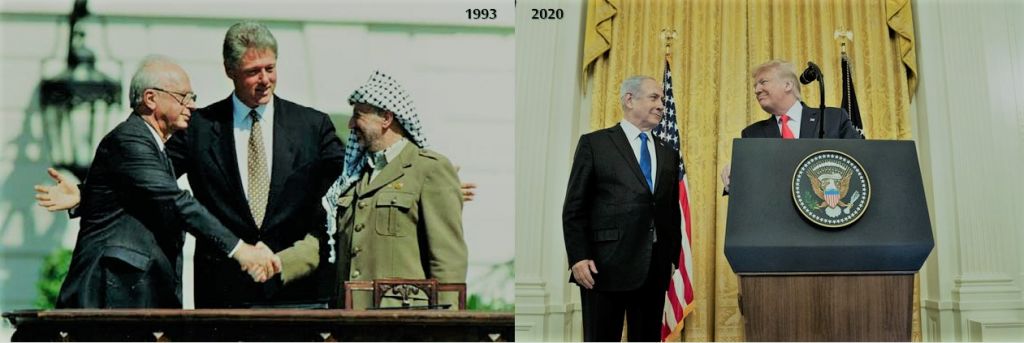Throughout the history of the American mediation in peace talks between the Israelis and the Palestinians, the United States had often leaned in one way or another towards Israel’s wants at the expense of the Palestinian side. Because of the world’s current political reality, the Palestinians had long accepted this playbook with a grain of salt, so long as at the end of the day there remained the overall conviction that the US will always know that for peace to be achieved there has to be a certain threshold of catering for the Palestinian needs. This, in fact, was the case with the successive US presidents; accepting that peace required a “viable” Palestinian state alongside Israel with Eastern Jerusalem as the capital, even if they were not to allow it equal sovereignty. This was also pretty much the international consensus.
Or at least, this was the direction of the American diplomacy up until Trump’s newly unveiled peace plan manifested a record high degree of American-Israeli alignment. In reality, this alignment was in the making since Donald Trump assumed office, revealing itself on several occasions: for example, when the Trump administration recognized Jerusalem as the Israeli capital and when it recognized Israel’s sovereignty over the Golan Heights. Since that time, Trump took quite a dive under the threshold of trust to be able to play the peace-broker. That distrust, naturally, took a dramatic turn with his plan that crossed many Palestinian red lines such as: (1) not having the pre-1967 boundary as the baseline for a potential agreement, (2) recognizing the Israeli sovereignty over West Bank settlements thus rewarding Israel’s “creating facts on the ground” approach, (3) while in theory still having the two-state formula in it, the provision shows a vision far less meaningful than the two-state solution envisaged by previous administrations with emphasis being placed on Israel’s security rather than Palestinian self-determination, and (4) regarding the central demand of the Palestinians to have eastern Jerusalem as their capital, the plan’s answer to that is to suggest they take Abu Dis, a neighborhood on the outskirts of Jerusalem and beyond the separation wall, and rename it ‘Al Quds’ – the historic Arabic name for Jerusalem. This formulation of a solution around the question of Jerusalem conveys the degree of misunderstanding the current US administration has of the spiritual attachment the Palestinians have to Jerusalem as part and parcel of their homeland.
Trump’s plan sweeps aside international consensus, like UN resolution 242 that emphasizes the inadmissibility of the acquisition of territory by war and erases the 1993 Oslo Accords which provided the structure of negotiation between the two sides and embodied the international consensus. It comes to no one’s surprise that Trump’s announcement, which came in a press conference alongside Benjamin Netanyahu, was cheered by standing ovations from attendees who were mostly from the American and the Israeli right wings, and was pronounced by Netanyahu as the “opportunity of the century.” Nor is it a surprise that the Palestinian President Mahmoud Abbas was not present at the conference and rejected the pan almost immediately arguing that Palestinian rights and hopes were not for sale.
Many view the conference to be quite a spectacle – an American president celebrating a peace plan in which only one side was present. In fact, due to its high unviability and problematic applicability, many are speculating that the announcement was motivated by domestic calculations more than anything. The two men at the podium needed distraction from what they are facing at home. Trump gets a distraction from his impeachment, and Netanyahu from facing criminal charges of corruption, bribery and breach of trust.
Regardless of the motives of its release timing, this plan would do more harm than good, at least on the short term. Palestinians and Israelis know from previous experiences that past peace initiatives are linked with turbulence, division and bloodshed. With this plan, the situation is even more complicated given its flawed provisions that triggered protests even before its announcement. It is an open invitation for violence. With that blunt compromise of the Palestinian rights, it is a blueprint for radicalization, especially since the status of Jerusalem had always been the main recruitment ground for many Palestinian resistance groups. Palestinians will be fueled by more anger, despair and hopelessness. The Trump plan is a bloody gamble in that sense. Protests are already taking place and violence is taking center stage with on-going clashes between Israeli forces and protestors in the West bank and Gaza.
Moreover, it is a bloody gamble when regarding the longstanding political rule that when negotiation channels are unavailable violence becomes the ultimate resort. With the US plan, from the start, the Palestinians were completely alienated from the process of drafting it, and were eventually given a “take it or leave it” offer, a process much closer to a Manifesto of how to start a war rather than to make peace.
The US plan is made with the mindset that Palestinians are people looking for an accommodation scheme not a nation in quest for statehood and homeland. It is also less of a negotiation framework and more of a “take it or leave it” offer for the Palestinians. This is usually when a broker tests positive for bias or even sponsorship which in turn renders void any real communication.


